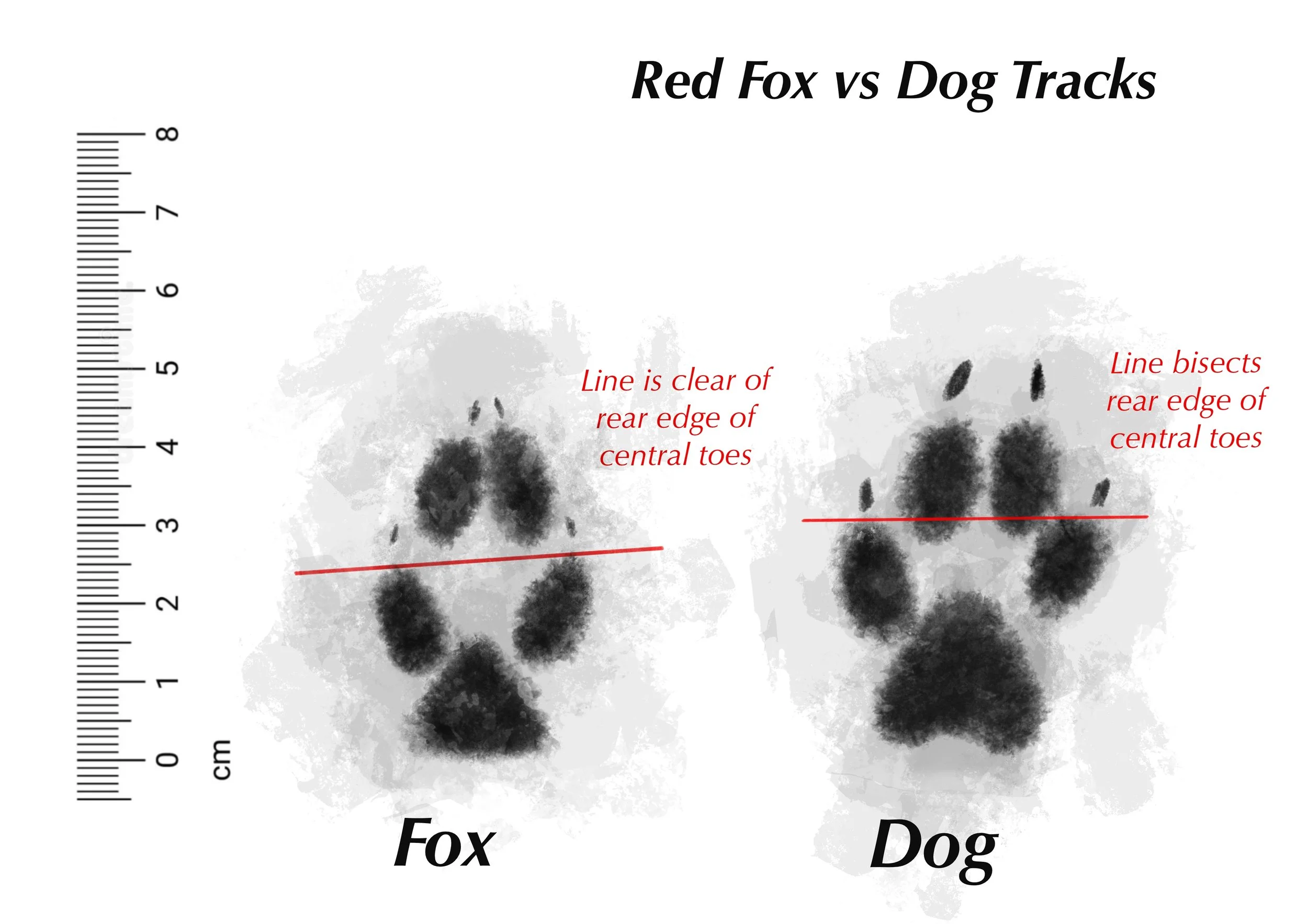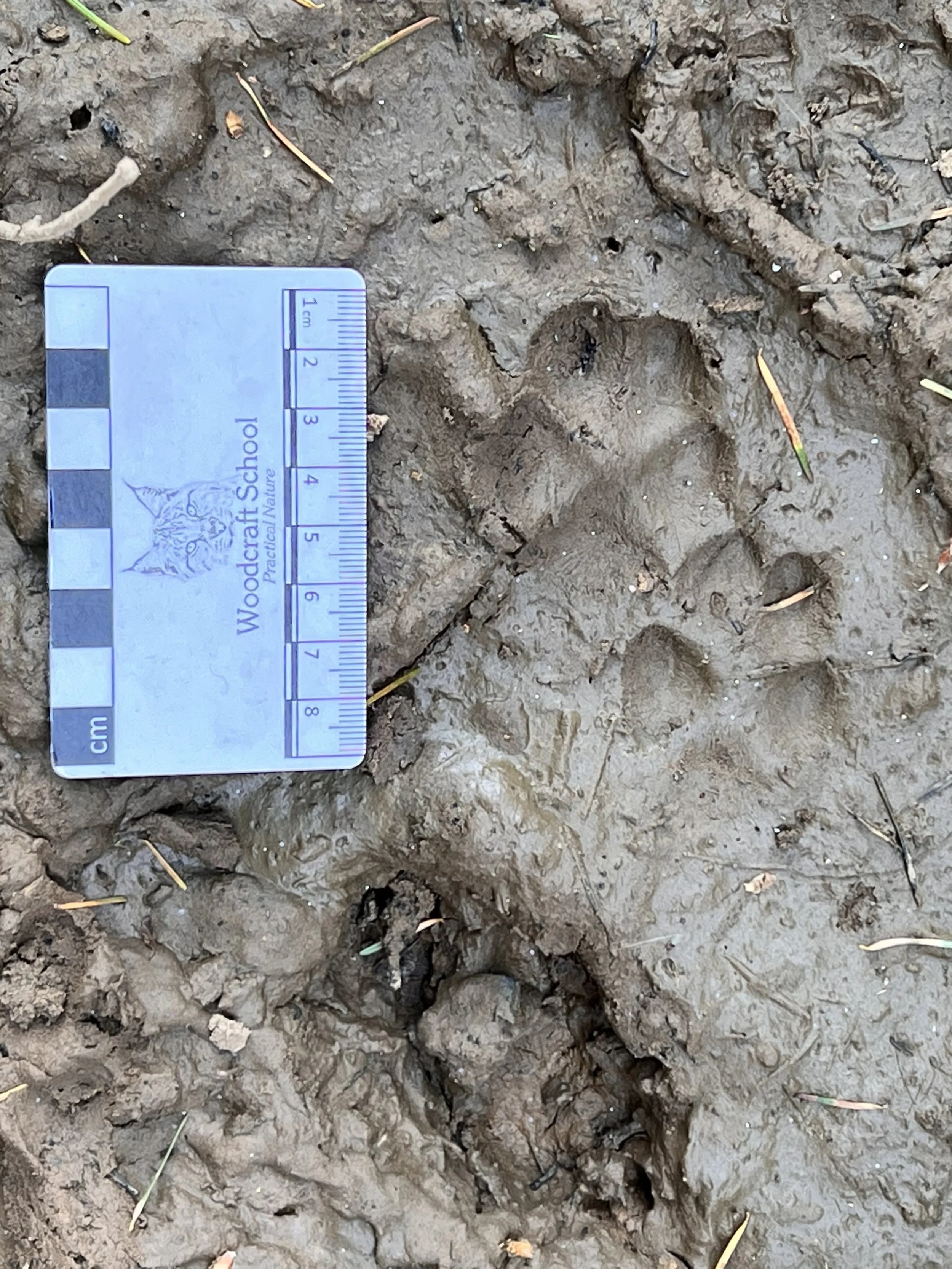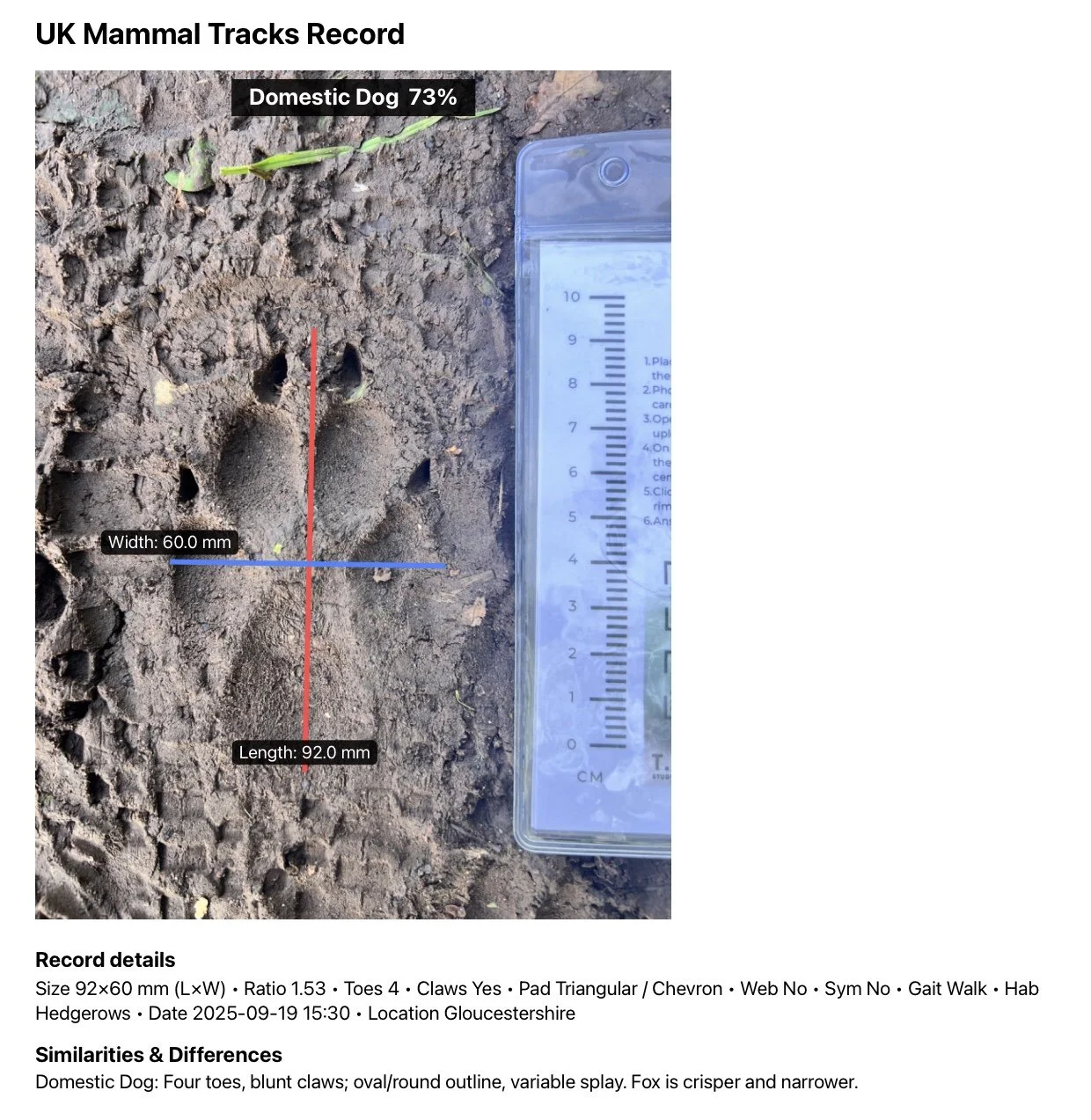Fieldcraft Friday: A Guide to Differentiating Between Dog and Fox Tracks
If you’ve ever wandered along a frosty track at dawn or followed the soft mud margins of a stream, chances are you’ve come across small canine prints. The question almost always arises: fox or dog? For naturalists and photographers alike, knowing the difference isn’t just a matter of trivia, it tells you who passed before you, what story the land holds, and whether you’re close to wild behaviour or simply retracing the steps of someone’s pet.
This distinction can be tricky. Domestic dogs are everywhere, ranging in size from tiny terriers to massive mastiffs. Foxes, on the other hand, are more consistent in size and have a more specialised way of moving. To tell the two apart requires not just looking at a single track but reading the trail: the sequence of prints, their spacing, their directness, and the subtle way the pads and claws press into the earth.
In this guide we’ll explore:
Toe, pad, and claw placement
Overall shape and size of tracks
Stride length and deviation from the median line
Differences in gait and trail patterns
Common areas for confusion and how to resolve them
By the end you’ll have a practical toolkit for reading the ground like a tracker, and for separating the wild fox from the ever-present dog.
The Anatomy of a Canine Track
Both dogs and foxes belong to the family Canidae, and their feet share the same fundamental structure:
Four toes that typically register (show up in the track).
Non-retractable claws that often leave impressions ahead of the toes.
A triangular or heart-shaped central pad.
At a glance this can make them appear almost identical. But subtle differences in shape, proportion, and pressure distribution reveal the species behind the print.
Toe Arrangement and Symmetry
Fox
Fox toes tend to be elongated and oval rather than round. When you look closely, the two central toes (the middle pair) are set slightly ahead of the outer pair, giving the foot a tapered look, almost like an arrow pointing forward. This symmetry creates a neat, tidy appearance.
Key features:
Toes are relatively close together.
Central toes extend forward, producing a clear point to the track.
Claws are fine and sharp, registering as small dots just beyond the toe tips.
The overall impression is of a track that looks compact, oval (or diamond shaped) and purposeful.
Dog
Dogs vary enormously by breed, but in general their toes are rounder and splayed more widely than foxes. Because of domestication, dogs lack the need for the perfect energy-efficient trot of a wild fox; their feet tend to spread more on soft ground, leaving a rounder, looser print.
Key features:
Toes more spread out, sometimes asymmetrical.
Central toes may not project as clearly.
Claws are blunter, thicker, and often leave heavier marks.
The impression is of a track that looks round, open, and sometimes sloppy compared to a fox.
The central toe position is one of the key differentiators between dog and fox prints. In foxes the central toes project well ahead of the outer 2 toes, in most dogs they do not. An easy way to look at this is to draw an imaginary line across the top of the 2 outer toes and to see if they “interfere” or “cross” the back edges of the central toes. If the horizontal line touches the central toes then it’s more likely to be a dog print. It doesn’t always hold true as some dogs breeds, known as “Hare footed” dogs (typically hounds) are more fox like in foot shape, but combined with the other indicators below it gives you a strong likelihood of fox over dog.
Relative toe position is a key indicator when determining if a print is from a dog or red fox. Here you can see the central toe position in relation to the outer toes in both species prints.
The Central or “Interdigital” Pad
Fox
The fox’s interdigital pad is relatively small and triangular, with a clear straight edge to the back edge which in firmer substrates or dry ground often shows as just a horizontal bar.
Dog
Dog pads are bulkier, often showing two lobes at the rear. The pad may register more strongly than a fox’s because of the dog’s greater weight distribution and more varied gaits.
This distinction in pad lobes is also a great feature to investigate:
Fox = one lobe, can look like just a straight bar
Dog = two rear lobes
Claw Marks
Both species have non-retractable claws, but their form differs.
Fox claws are fine, sharp, and leave narrow pin-prick impressions. They rarely splay far from the toe tip and often look delicate.
Dog claws are thicker, blunter, and leave broader gouges ahead of the toes. In soft earth, they may tear the soil rather than prick it.
Look for refinement: fox claws are almost pencil-drawn, while dog claws are more like a child’s crayon mark.
Size Ranges
Size is not always definitive (because of breed variation in dogs), but it can help.
Fox prints: Typically 4–5 cm long by 3.5–4.5 cm wide (fore slightly larger than hind). Consistency across individuals is high.
Dog prints: Range from tiny terrier (2.5 cm long) to German Shepherd (9–10 cm long). This variation makes dog prints less predictable, but when you find a track in the fox range, the other features (symmetry, pad shape, claw marks) become crucial.
In snow, remember that fox prints often appear slightly smaller than dog prints because of their tighter, more compact form.
A direct registered print of a red fox. As you will read below foxes are super efficient travellers and often place their hind foot exactly on top of their forefoot print.
Stride and Gait Pattern
A single print can fool you. A line of prints tells the truth.
Fox
Foxes are masters of energy-efficient movement. They usually travel in a direct register trot: the hind foot lands almost exactly in the same place as the forefoot (or at least their feet placed very closely together). The result is a neat, straight line of evenly spaced prints, often along the median line (the imaginary line of travel).
Stride length: 30–40 cm typically.
Prints fall in near-perfect straightness, like a dotted line drawn with a ruler.
Trails often run directly from A to B with little deviation.
Direct register trot most common.
Occasionally a walk, but still tight and straight.
Rare gallops or bounds unless hunting or fleeing.
Dog
Dogs are wanderers. Even when trotting, they often veer side to side, stop, backtrack, or meander. Their tracks frequently splay out from the median line, creating a trail that looks messy compared to a fox.
Stride length: variable, depending on breed and gait.
Trails rarely form neat, straight lines.
Expect frequent pauses, overlaps, and changes of direction.
Walks, trots, lopes, bounds, side steps.
Playful circling and sniffing behaviour leaves chaotic trails.
In short:
Fox = ruler straight, neat, energy efficient.
Dog = wandering, sloppy, playful.
Deviation from the Median Line
A strong differentiator.
Fox: Tracks hug the central line of travel. Imagine the fox pulling an invisible string taut — its footprints fall neatly along it. Hind feet often land almost directly on or very close to that line.
Dog: Prints frequently fall wide of the line. The overall trail looks broader, almost weaving.
This is partly due to domestication: dogs don’t need to conserve energy over long distances, while foxes survive by moving economically.
Common Areas of Confusion
Small Dogs vs Fox
Terriers and collies produce prints very close in size to foxes. Distinguishing them requires close inspection of pad lobes, claw marks, and trail directness.
Substrate Issues
In mud, prints may splay and exaggerate dog-like features.
In snow, melting and refreezing can distort shapes.
On hard ground, only partial prints register, making features less clear.
Fox Cubs
Young foxes produce smaller, rounder tracks that may resemble toy breeds of dog. Only by noting the straight trail and consistent size across prints can you resolve the identity.
Putting It All Together: A Tracking Checklist
When you find a canine print in the field, ask yourself:
Shape — Is the print neat and oval (fox) or round and splayed (dog)?
Pad — Single rear lobe (fox) or double lobes (dog)?
Claws — Fine pin-pricks (fox) or blunt gouges (dog)?
Symmetry — Arrowhead forward-pointing (fox) or more open/irregular (dog)?
Size — Within fox’s 4–5 cm range, or outside?
Trail — Straight purposeful line (fox) or wandering (dog)?
Context — Remote field edge at dawn (likely fox) or footpath near a village (likely dog)?
It’s the accumulation of evidence that builds certainty.
Field Examples
Woodland Path, Winter Dawn: Frost holds perfect tracks. Neat 4.5 cm ovals, claws fine, line arrow-straight for 200 m along a ride edge. Almost certainly fox.
Riverside Mud, Afternoon: Similar size prints, but splayed toes, heavy blunt claws, weaving trail that loops to the water and back. Dog on a walk.
Urban Edge Snow: Small, consistent tracks across allotments, pad lobes single, direct path between gardens. Classic urban fox route.
Why It Matters
Beyond academic interest, distinguishing fox from dog has practical and ethical value. For wildlife photographers, it prevents wasted hours following pet trails instead of wild animals. For conservationists, it improves survey accuracy. For naturalists, it enriches the story told by the land.
Most importantly, it develops fieldcraft: the ability to look closely, interpret, and move with the lives of other animals.
Conclusion
Learning to tell fox from dog in the field is less about memorising diagrams and more about practice: kneeling in mud, leaning close to snow, following a line of tracks across dew-wet grass. The more you look, the clearer the differences become.
Remember:
Fox tracks are neat, compact, and purposeful.
Dog tracks are varied, open, and meandering.
Each print is a clue, but the whole trail is the story. The fox writes in fine script, straight and efficient; the dog scrawls in bold, playful loops. Once you know how to read it, you’ll never confuse the two again.
——————————————————-
Fox vs Dog print FAQ
How can you tell the difference between fox and dog paw prints?
Fox tracks are typically neater, narrower, and more oval than dog tracks. The fox’s central pad shows one rear lobe, whereas dogs usually have two lobes. Fox claws leave fine, sharp marks while dog claws appear thicker and blunter. Perhaps the biggest giveaway is the trail: foxes move in straight, purposeful lines, while dogs tend to wander and meander.
What size are fox footprints compared to dog footprints?
Adult red fox tracks in the UK measure around 4–5 cm long and 3.5–4.5 cm wide. Dog prints vary enormously with breed, from as little as 2.5 cm for toy breeds to over 9 cm for large working dogs. If a track is within fox range, you’ll need to rely on shape, pad structure, and gait rather than size alone to confirm which species made it.
Do fox tracks always appear in a straight line?
Foxes usually travel in a direct register trot, where the back foot lands almost in the same spot as the front foot. This produces a straight, energy-efficient line of prints, often hugging the median line. By contrast, dogs rarely move in such a tidy fashion — their prints zigzag, overlap, or deviate widely, reflecting playful or distracted behaviour.
Can dog tracks be mistaken for fox tracks?
Yes, especially with medium-sized dogs like collies or terriers, whose print dimensions overlap with foxes. The confusion is common in mud or snow, where tracks spread or distort. To tell them apart, check for pad lobes (one vs. two), claw sharpness, and the overall trail pattern. A fox’s trail will almost always look more compact and direct, whereas a dog’s looks broader and untidy.




